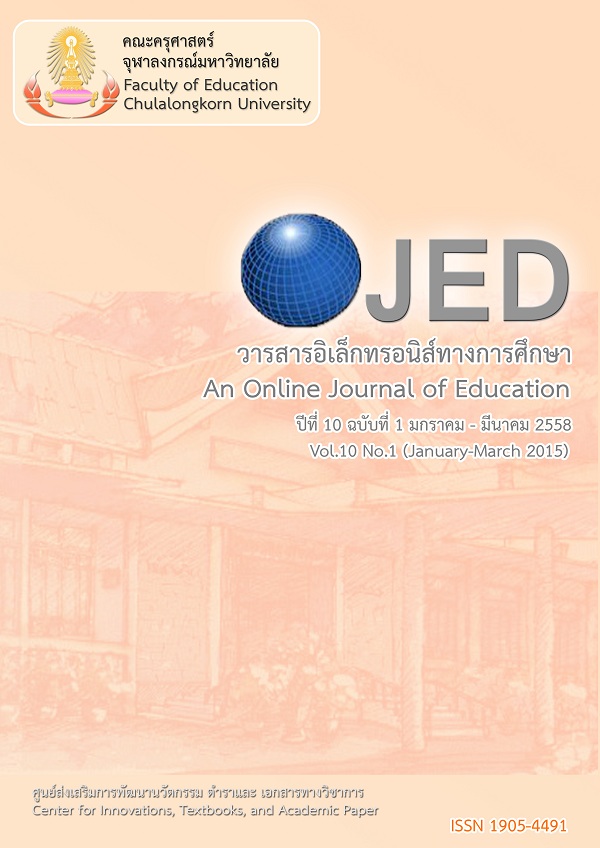ผลของการจัดประสบการณ์วิทยาศาสตร์โดยใช้ศิลปะแบบบูรณาการที่มีต่อทักษะกระบวนการทางวิทยาศาสตร์ของเด็กอนุบาล
Keywords:
การจัดประสบการณ์วิทยาศาสตร์ / ศิลปะแบบบูรณาการ / ทักษะกระบวนการทางวิทยาศาสตร์/ เด็กอนุบาล/ SCIENCE EXPERIENCES / ARTS INTEGRATION / SCIENCE PROCESS SKILLS / KINDERGARTENERSAbstract
การวิจัยครั้งนี้มีวัตถุประสงค์เพื่อ 1) ศึกษาผลของการจัดประสบการณ์วิทยาศาสตร์โดยใช้ศิลปะแบบบูรณาการที่มีต่อทักษะกระบวนการทางวิทยาศาสตร์ของเด็กอนุบาล ได้แก่ ทักษะการสังเกต ทักษะการจำแนก ทักษะการวัด และทักษะการสื่อความหมาย 2) เปรียบเทียบผลของการจัดประสบการณ์วิทยาศาสตร์โดยใช้ศิลปะแบบบูรณาการกับการจัดประสบการณ์วิทยาศาสตร์แบบปกติที่มีต่อทักษะกระบวนการทางวิทยาศาสตร์ของเด็กอนุบาล ตัวอย่างประชากรเป็นเด็กอนุบาลชั้นปีที่ 2 ปีการศึกษา 2557 โรงเรียนวัดเกาะถ้ำและโรงเรียนชุมชนบ้านด่าน สังกัดสำนักงานเขตพื้นที่การศึกษาประถมศึกษาสงขลาเขต 1 จำนวน 38 คน โดยแบ่งเป็นกลุ่มทดลอง 19 คน ซึ่งใช้การจัดประสบการณ์วิทยาศาสตร์โดยใช้ศิลปะแบบบูรณาการ และกลุ่มควบคุม 19 คน ซึ่งเป็น ใช้การจัดประสบการณ์วิทยาศาสตร์แบบปกติ ระยะเวลาใน การเก็บรวบรวมข้อมูล 10 สัปดาห์ เครื่องมือที่ใช้ในการวิจัยคือ แบบวัดทักษะกระบวนการทางวิทยาศาสตร์ของเด็กอนุบาล วิเคราะห์ข้อมูลโดยหาค่าเฉลี่ย ส่วนเบี่ยงเบนมาตรฐาน และการทดสอบค่าที
ผลการวิจัยพบว่า 1) หลังการทดลอง กลุ่มทดลองมีค่าเฉลี่ยคะแนนทักษะกระบวนการทางวิทยาศาสตร์ทั้ง 4 ด้านสูงกว่าก่อนการทดลองอย่างมีนัยสำคัญทางสถิติที่ระดับ .01 2) หลังการทดลอง กลุ่มทดลองมีค่าเฉลี่ยคะแนนทักษะกระบวนการทางวิทยาศาสตร์ทั้ง 4 ด้าน สูงกว่าค่าเฉลี่ยคะแนนกลุ่มของควบคุมอย่างมีนัยสำคัญทางสถิติที่ระดับ .01
The purposes of this research were to 1) study effects of organizing science experiences using arts integration on science process skills of kindergarteners in 4 aspects: observation, classification, measurement, and communication 2) compare the effects of organizing science experiences using arts integration on science process skills between experimental group and control group. The samples were 38 kindergarteners at the age of five to six years in academic year 2014 from Watkohtam school and Chumchon Ban Dan school under the Songkhla Primary Educational Service Area Office 1. The sample was divided into two groups; 19 children for the experimental group and 19 children for the control group. The experimental group used the organizing science experiences using arts integration; whereas the control group used the conventional organizing science experiences. The research duration was 12 weeks. The data collection was through the test of science process skills of kindergarteners. The data was statistically analyzed by using arithmetic mean, standard deviation, and t-test.
The research findings were as follows: 1) After the experiment, the experimental group had the mean scores of the science process skills higher than those of before at.01 level of significance. 2) After the experiment, the experimental group had mean scores of the science process skills higher than that of control group at.01 level of significance.




